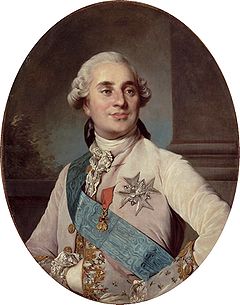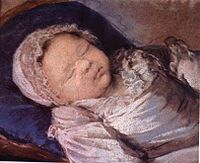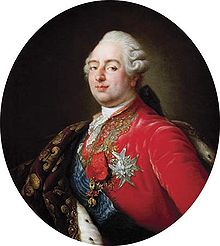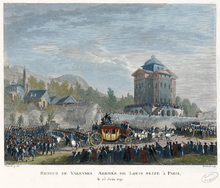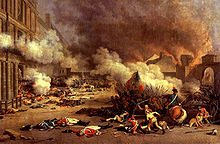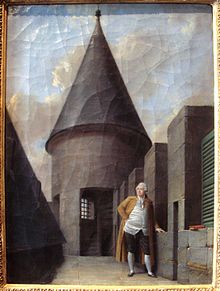- Louis XVI of France
-
Louis XVI 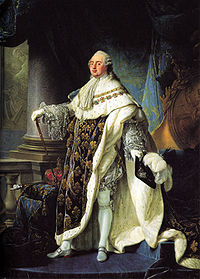
Louis XVI by Antoine-François Callet King of France and Navarre Reign 10 May 1774 – 1 October 1791
(17 years, 144 days)Coronation 11 June 1775 (aged 20) Predecessor Louis XV Successor Himself as King of the French King of the French Reign 1 October 1791 – 21 September 1792 (356 days) Predecessor Himself as King of France and Navarre Successor Monarchy abolished
National Convention
ruling legislative body of the French First Republic
Louis XVII as the de jure successor and heir.
Next reigning monarch in France was Napoleon I starting 1804.Spouse Marie Antoinette Issue Marie Thérèse, Queen of France and Navarre
Louis Joseph, Dauphin of France
Louis XVII of France
Princess SophieFull name Louis Auguste de France House House of Bourbon Father Louis, Dauphin of France Mother Marie-Josèphe of Saxony Born 23 August 1754
Palace of Versailles, FranceDied 21 January 1793 (aged 38)
Place de la Révolution, Paris, FranceBurial 21 January 1815
Saint Denis Basilica, FranceSignature 
Religion Roman Catholicism Louis XVI (23 August 1754 – 21 January 1793) was a Bourbon monarch who ruled as King of France and Navarre until 1791, and then as King of the French from 1791 to 1792. Suspended and arrested as part of the insurrection of 10 August during the French Revolution, he was tried by the National Convention, found guilty of high treason, and executed by guillotine on 21 January 1793 as a desacralized French citizen known as "Citoyen Louis Capet". He is the only King of France ever to be executed.
Although Louis XVI was beloved at first, his indecisiveness and conservatism led some elements of the people of France to eventually view him as a symbol of the perceived tyranny of the Ancien Régime and gave him the nickname Oncle Louis ("Uncle Louis"). After the abolition of the monarchy in 1792, the new republican government gave him the surname Capet, a nickname in reference to Hugh Capet, the founder of the Capetian dynasty – which the revolutionaries interpreted as a family name.
Contents
Childhood
Louis Auguste de France, who was given the title Duc de Berry at birth, was born in the Palace of Versailles. Out of seven children, he was the third son of Louis, the Dauphin of France, and thus the grandson of Louis XV of France and of his consort, Maria Leszczyńska. His mother was Marie-Josèphe of Saxony, the daughter of Frederick Augustus II of Saxony, Prince-Elector of Saxony and King of Poland.
Louis-Auguste had a difficult childhood because his parents neglected him in favour of his, said to be, bright and handsome older brother, Louis, duc de Bourgogne, who died at the age of nine in 1761. A strong and healthy boy, but very shy, Louis-Auguste excelled in his studies and had a strong taste for Latin, history, geography and astronomy, and became fluent in Italian and English. He enjoyed physical activities such as hunting with his grandfather, Louis XV, and rough-playing with his younger brothers, Louis-Stanislas, comte de Provence, and Charles-Philippe, comte d'Artois. From an early age, Louis-Auguste had been encouraged in another of his hobbies: locksmithing, which was seen as a 'useful' pursuit for a child.[1]
Upon the death of his father, who died of tuberculosis on 20 December 1765, the eleven-year-old Louis-Auguste became the new Dauphin. His mother, who had never recovered from the loss of her husband, died on 13 March 1767, also from tuberculosis.[2] The strict and conservative education he received from the Duc de La Vauguyon, "gouverneur des Enfants de France" (governor of the Children of France), from 1760 until his marriage in 1770, did not prepare him for the throne that he was to inherit in 1774 after the death of his grandfather, Louis XV.
Family life
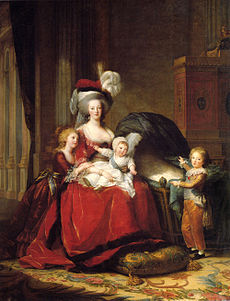 Marie Antoinette Queen of France with her three eldest children, Marie-Thérèse, Louis-Charles and Louis-Joseph. Princess Sophie Hélène Béatrix of France, originally in the cradle, was painted out after her death. By Marie Louise Élisabeth Vigée-Lebrun
Marie Antoinette Queen of France with her three eldest children, Marie-Thérèse, Louis-Charles and Louis-Joseph. Princess Sophie Hélène Béatrix of France, originally in the cradle, was painted out after her death. By Marie Louise Élisabeth Vigée-Lebrun
On 16 May 1770, at the age of fifteen, Louis-Auguste married the fourteen-year-old Habsburg Archduchess Maria Antonia (better known by the French form of her name, Marie Antoinette), his second cousin once removed and the youngest daughter of the Holy Roman Emperor Francis I and his wife, the formidable Empress Maria Theresa.
This marriage was met with some hostility by the French public. France's alliance with Austria had pulled France into the disastrous Seven Year War, in which France was defeated by the British, both in Europe and in North America. By the time that Louis-Auguste and Marie-Antoinette were married, the people of France generally regarded the Austrian alliance with dislike, and Marie-Antoinette was seen as an unwelcome foreigner.[3] For the young couple, the marriage was initially amiable but distant – Louis-Auguste's shyness meant that he failed to consummate the union, much to his wife's distress, while his fear of being manipulated by her for Imperial purposes caused him to behave coldly towards her in public.[4] Over time, the couple became closer, though while their marriage was reportedly consummated in July 1773, it was not in fact really so until 1777.[5]
Nevertheless, the royal couple failed to produce any children for several years after this, placing a strain upon their marriage,[6] whilst the situation was worsened by the publication of obscene pamphlets (libelles) which mocked the infertility of the pair. One questioned, "Can the King do it? Can't the King do it?"[7]
The reasons behind the couple's initial failure to have children were debated at that time, and they have continued to be so since. One suggestion is that Louis-Auguste suffered from a physiological dysfunction,[8] most often thought to be phimosis, a suggestion first made in late 1772 by the royal doctors.[9] Historians adhering to this view suggest that he was circumcised[10] (a common treatment for phimosis) to relieve the condition seven years after their marriage. Louis's doctors were not in favour of the surgery – the operation was delicate and traumatic, and capable of doing "as much harm as good" to an adult male. The argument for phimosis and a resulting operation is mostly seen to originate from Stefan Zweig.[11]
However, it is agreed amongst most modern historians that Louis had no surgery[12][13][14] – for instance, as late as 1777, the Prussian envoy, Baron Goltz, reported that the King of France had definitely declined the operation.[15] The fact was that Louis was frequently declared to be perfectly fit for sexual intercourse, confirmed by Joseph II, and during the time he was purported to have had the operation, he went out hunting almost every day, according to his journal. This would not have been possible if he had undergone a circumcision; at the very least, he would have been unable to go out hunting for a few weeks after. Their consummation problems have now been attributed to other factors, around which controversy and argument still enshroud today.
In the long run, and in spite of all their earlier difficulty, the Royal couple became the parents of four children:
- Marie-Thérèse-Charlotte (19 December 1778 – 19 October 1851)
- Louis-Joseph-Xavier-François, the Dauphin (22 October 1781 – 4 June 1789)
- Louis-Charles (the future titular King Louis XVII of France) (27 March 1785 – 8 June 1795)
- Sophie-Hélène-Béatrix, who died in infancy (9 July 1786 – 19 June 1787)
The absolute monarch of France, 1774–1788
When Louis XVI succeeded to the throne in 1774, he was not yet 20 years old. He had an enormous responsibility, as the government was deeply in debt, and resentment to 'despotic' monarchy was on the rise. Louis also felt woefully unqualified for the job. The King, his brothers and Marie Antoinette became fellows of the masonic lodge Trois Frères à l'Orient de Versailles.[16]
He aimed to earn the love of his people by reinstating the parlements. While none doubted Louis's intellectual ability to rule France, it was quite clear that, although raised as the Dauphin since 1765, he lacked firmness and decisiveness. In spite of his indecisiveness, Louis was determined to be a good king, stating that he "must always consult public opinion; it is never wrong."[17] Louis therefore appointed an experienced advisor, Jean-Frédéric Phélypeaux, comte de Maurepas who, until his death in 1781, would take charge of many important ministerial functions.
Radical financial reforms by Turgot and Malesherbes angered the nobles and were blocked by the parlements who insisted that the King did not have the legal right to levy new taxes. So, in 1776, Turgot was dismissed and Malesherbes resigned, to be replaced by Jacques Necker. Necker supported the American Revolution, and he carried out a policy of taking out large international loans instead of raising taxes. When this policy failed miserably, Louis dismissed him, and then replaced him in 1783 with Charles Alexandre de Calonne, who increased public spending to "buy" the country's way out of debt. Again this failed, so Louis convoked the Assembly of Notables in 1787 to discuss a revolutionary new fiscal reform proposed by Calonne. When the nobles were informed of the extent of the debt, they were shocked into rejecting the plan. This negative turn of events signaled to Louis that he had lost the ability to rule as an absolute monarch, and he fell into depression.[18]
As power drifted from him, there were increasingly loud calls for him to convoke the Estates-General, which had not met since 1614, at the beginning of the reign of Louis XIII. As a last-ditch attempt to get new monetary reforms approved, Louis XVI convoked the Estates-General on 8 August 1788, setting the date of their opening at 1 May 1789. With the convocation of the Estates-General, as in many other instances during his reign, Louis placed his reputation and public image in the hands of those who were perhaps not as sensitive to the desires of the French public as he was. Because it had been so long since the Estates-General had been convened, there was some debate as to which procedures should be followed. Ultimately, the parlement de Paris agreed that "all traditional observances should be carefully maintained to avoid the impression that the Estates-General could make things up as it went along." Under this decision, the King agreed to retain many of the divisionary customs which had been the norm in 1614, but which were intolerable to a Third Estate buoyed by the recent proclamations of equality. For example, the First and Second Estates proceeded into the assembly wearing their finest garments, while the Third Estate was required to wear plain, oppressively somber black, an act of alienation that Louis would likely have not condoned. He seemed to regard the deputies of the Estates-General with at least respect: in a wave of self-important patriotism, members of the Estates refused to remove their hats in the King's presence, so Louis removed his to them.[19]
This convocation was one of the events that transformed the general economic and political malaise of the country into the French Revolution, which began in June 1789, when the Third Estate unilaterally declared itself the National Assembly. Louis's attempts to control it resulted in the Tennis Court Oath (serment du jeu de paume), on 20 June, and the declaration of the National Constituent Assembly on 9 July. Within three short months, the majority of the king's executive authority had been transferred to the elected representatives of the people's nation. The storming of the Bastille on 14 July served to reinforce and emphasize this radical change in the mind of the masses.
Foreign policy
Main articles: Franco-American alliance, Franco-Indian alliances, and French assistance to Nguyễn ÁnhSurrender of Cornwallis to French (left) and American (right) troops, at the Siege of Yorktown in 1781, by John Trumbull.
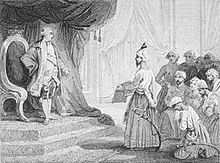 Louis XVI receives the ambassadors of Tippu Sultan in 1788, Voyer after Emile Wattier, 19th century.
Louis XVI receives the ambassadors of Tippu Sultan in 1788, Voyer after Emile Wattier, 19th century.
French involvement in the Seven Years War had left Louis XVI a disastrous inheritance. Britain's victories had seen them capture most of France's colonial territories. While some were returned to France at the 1763 Treaty of Paris a vast swathe of North America was ceded to the British.
This had led to a strategy amongst the French leadership of seeking to rebuild the French military in order to fight a war of revenge against Britain, in which it was hoped the lost colonies could be recovered. France still maintained a strong influence in the West Indies, and in India maintained five trading posts, leaving opportunities for disputes and power-play with Great Britain.[20]
Concerning the American Revolution
Main article: France in the American Revolutionary WarIn the spring of 1776, Vergennes, the Foreign Secretary, saw an opportunity to humiliate France's long-standing enemy, Great Britain, as well as recover territory lost during the Seven Years' War, by supporting the American Revolution. Louis XVI was convinced by Pierre Beaumarchais to secretly send supplies, ammunition and guns from 1776, sign a formal Treaty of Alliance in early 1778, and go to war with Britain. Spain and the Netherlands soon joined the French in an anti-British coalition.
France's initial military assistance to the American rebels was a disappointment with defeats at Rhode Island and Savannah. In 1780 France sent Rochambeau and de Grasse to help the Americans, along with large land and naval forces. The French expeditionary force arrived in America in July 1780. The appearance of French fleets in the Caribbean was followed by the capture of a number of the sugar islands, including Tobago and Grenada.[21] French intervention proved decisive in forcing a British army under Lord Cornwallis to surrender at the Battle of Yorktown in 1781.[22]
The Americans gained their independence, and the war ministry rebuilt the French Army. However, the British defeated the main French fleet in 1782 and successfully defended the island of Jamaica. France gained little from the Treaty of Paris (of 1783) that ended the war, except the colonies of Tobago and Senegal. Louis was wholly disappointed in his aim of recovering Canada from Britain. The war cost 1,066 million livres, financed by new loans at high interest (with no new taxes). Necker concealed the crisis from the public by explaining only that ordinary revenues exceeded ordinary expenses, and not mentioning the loans. After he was forced from office in 1781, new taxes were levied.[23]
Concerning India
Louis XVI also wished to expel the British from India.[20] In 1782, Louis XVI sealed an alliance with the Peshwa Madhu Rao Narayan. As a consequence Bussy moved his troops to the Île de France (Mauritius) and later contributed to the French effort in India in 1783.[20][24] Suffren became the ally of Hyder Ali in the Second Anglo-Mysore War against British rule in India, in 1782–1783, fighting the British fleet along the coasts of India and Ceylon.[25][26]
Concerning Vietnam and Indo-China
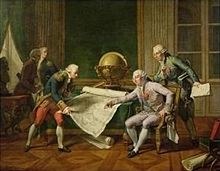 Louis XVI giving La Pérouse his instructions
Louis XVI giving La Pérouse his instructions
France also intervened in Vietnam following Mgr Pigneau de Behaine's intervention to obtain military aid. A France-Vietnam alliance was signed through the Treaty of Versailles of 1787, between Louis XVI and Prince Nguyễn Ánh. As the French regime was under considerable strain, France was unable to follow through with the application of the Treaty, but Mgr Pigneau de Behaine persisted in his efforts and with the support of French individuals and traders mounted a force of French soldiers and officers that would contribute to the modernization
Concerning world exploration
Louis XVI also encouraged major voyages of exploration. In 1785, he appointed La Pérouse to lead a sailing expedition around the world.
Revolutionary constitutional reign, 1789–1792
Silver Ecu of Louis XVI, struck 1785 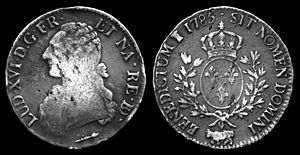
Obverse: (Latin) LUD[OVICVS] XVI D[EI] G[RATIA] FR[ANCIA] ET NA[VARRE] RE[X] or in English, "Louis XVI, By the Grace of God, King of France and Navarre." Reverse: (Latin) SIT NOMEN DOMINI BENEDICTUM 1785, or in English, "Blessed Be the Name of the Lord, 1785." On 5 October 1789, an angry mob of Parisian working women was incited by revolutionaries and marched on the Palace of Versailles, where the royal family lived. During the night, they infiltrated the palace and attempted to kill the queen, who was associated with a frivolous lifestyle that symbolized much that was despised about the Ancien Régime. After the situation had been defused, the king and his family were brought by the crowd to the Tuileries Palace in Paris. The reasoning behind this forced departure from Versailles was the opinion the king would be more accountable to the people if he lived among them in Paris.
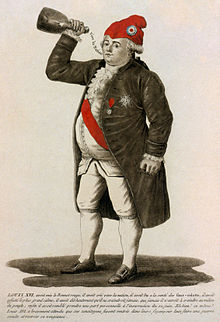 Tinted etching of Louis XVI, 1792. The caption refers to the date of the Tennis Court Oath and concludes "The same Louis XVI who bravely waits until his fellow citizens return to their hearths to plan a secret war and exact his revenge."
Tinted etching of Louis XVI, 1792. The caption refers to the date of the Tennis Court Oath and concludes "The same Louis XVI who bravely waits until his fellow citizens return to their hearths to plan a secret war and exact his revenge."
Initially, after the removal of the royal family to Paris, Louis maintained a certain level of popularity by acquiescing to many of the social, political, and economic reforms of the revolutionaries. Unbeknownst to the public, however, recent scholarship[citation needed] has concluded that Louis began to suffer at the time from severe bouts of clinical depression, which left him prone to paralyzing indecisiveness[citation needed]. During these indecisive moments, his wife, the unpopular queen, was essentially forced into assuming the role of decision-maker for the Crown[citation needed].
The revolution's principles of popular sovereignty, though central to democratic principles of later eras, marked a decisive break from the absolute monarchical principle that was at the heart of traditional French government. As a result, the revolution was opposed by many of the rural people of France and by practically all the governments of France's neighbors. As the revolution became more radical and the masses became more uncontrollable, several leading figures in the initial formation of the revolution began to doubt its benefits. Some like Honoré Mirabeau secretly plotted with the Crown to restore its power in a new constitutional form.
Beginning in 1791, Montmorin, Minister of Foreign Affairs, started to organize covert resistance to the Revolutionary forces. Thus, the funds of the Civil List (la Liste civile), voted annually by the National Assembly were partially assigned to secret expenses in order to preserve the monarchy. Arnault Laporte was in charge of the Civil List and he collaborated with both Montmorin and Mirabeau. After the sudden death of Mirabeau, Maximilien Radix de Sainte-Foix, a noted financier, took his place. In effect, he headed a secret council of advisers to the King that tried to preserve the Monarchy; these schemes proved unsuccessful, and were exposed later as the armoire de fer scandal.
Mirabeau's death, and Louis's indecision, fatally weakened negotiations between the Crown and moderate politicians. On one hand, Louis was nowhere near as reactionary as his brothers, the comte de Provence[citation needed] and the comte d'Artois, and he repeatedly sent messages to them requesting a halt to their attempts to launch counter-coups. This was often done through his secretly nominated regent, the Cardinal Loménie de Brienne. On the other hand, Louis was alienated from the new democratic government both by its negative reaction to the traditional role of the monarch and in its treatment of him and his family. He was particularly irked by being kept essentially as a prisoner in the Tuileries, where his wife was being humiliatingly forced to have revolutionary soldiers in her private bedroom watching her as she slept, and by the refusal of the new regime to allow him to have confessors and priests of his choice rather than 'constitutional priests' pledged to the state and not the Roman Catholic Church.
On 21 June 1791, Louis attempted to secretly flee with his family from Paris to the royalist fortress town of Montmédy on the northeastern border of France.[27] While the National Assembly worked painstakingly towards a constitution, Louis and Marie-Antoinette were involved in plans of their own. Louis had appointed the baron de Breteuil to act as plenipotentiary, dealing with other foreign heads of state in an attempt to bring about a counter-revolution. As tensions in Paris rose and Louis was pressured to accept measures from the Assembly against his will, the King and Queen plotted to secretly escape from France. Beyond escape, they hoped to raise an "armed congress" with the help of the émigrés who had fled, as well as assistance from other nations, with which they could return and, in essence, recapture France. This degree of planning reveals Louis’ political determination; unfortunately it was for this determined plot that he was eventually convicted of high treason.[28] However, flaws in its plan and lack of rapidity were responsible for the failure of the escape. The royal family was arrested at Varennes-en-Argonne shortly after Jean-Baptiste Drouet, postmaster of the town of Sainte-Menehould, had recognised the king from his profile on a golden écu, and had given the alert. Louis XVI and his family were brought back to Paris where they arrived on 25 June. Viewed suspiciously as traitors, they were placed under tight house arrest upon their return to the Tuileries.
The other monarchies of Europe looked with concern upon the developments in France, and considered whether they should intervene, either in support of Louis or to take advantage of the chaos in France. The key figure was Marie Antoinette's brother, the Holy Roman Emperor Leopold II. Initially, he had looked on the revolution with equanimity. However, he became more and more disturbed as it became more and more radical. Despite this, he still hoped to avoid war.
On 27 August, Leopold and King Frederick William II of Prussia, in consultation with émigrés French nobles, issued the Declaration of Pillnitz, which declared the interest of the monarchs of Europe in the well-being of Louis and his family, and threatened vague but severe consequences if anything should befall them. Although Leopold saw the Pillnitz Declaration as an easy way to appear concerned about the developments in France without committing any soldiers or finances to change them, the revolutionary leaders in Paris viewed it fearfully as a dangerous foreign attempt to undermine France's sovereignty.
In addition to the ideological differences between France and the monarchical powers of Europe, there were continuing disputes over the status of Austrian estates in Alsace, and the concern of members of the National Constituent Assembly about the agitation of émigrés nobles abroad, especially in the Austrian Netherlands and the minor states of Germany.
In the end, the Legislative Assembly, supported by Louis, declared war on the Holy Roman Empire first, voting for war on 20 April 1792, after a long list of grievances was presented to it by the foreign minister, Charles François Dumouriez. Dumouriez prepared an immediate invasion of the Austrian Netherlands, where he expected the local population to rise against Austrian rule. However, the revolution had thoroughly disorganised the army, and the forces raised were insufficient for the invasion. The soldiers fled at the first sign of battle, deserting en masse and, in one case, murdering their general[citation needed].
While the revolutionary government frantically raised fresh troops and reorganised its armies, a mostly Prussian allied army under Charles William Ferdinand, Duke of Brunswick assembled at Coblenz on the Rhine. In July, the invasion commenced, with Brunswick's army easily taking the fortresses of Longwy and Verdun. The duke then issued on 25 July a proclamation called the Brunswick Manifesto, written by Louis's émigré cousin, the Prince de Condé, declaring the intent of the Austrians and Prussians to restore the king to his full powers and to treat any person or town who opposed them as rebels to be condemned to death by martial law.
Contrary to its intended purpose of strengthening the position of the King against the revolutionaries, the Brunswick Manifesto had the opposite effect of greatly undermining Louis's already highly tenuous position in Paris. It was taken by many to be the final proof of a collusion between Louis and foreign powers in a conspiracy against his own country. The anger of the populace boiled over on 10 August when a group of Parisians – with the backing of a new municipal government of Paris that came to be known as the "insurrectionary" Paris Commune – besieged the Tuileries Palace. The king and the royal family took shelter with the Legislative Assembly.
The imprisonment and execution of Louis, 1792–1793
See also: trial of Louis XVI and execution of Louis XVILouis was officially arrested on the 13 August 1792, and sent to the Temple, an ancient fortress in Paris that was used as a prison. On 21 September, the National Assembly declared France to be a Republic and abolished the Monarchy. Louis was stripped of all of his titles and honours, and from this date was known as simply Citoyen Louis Capet.
The Girondins were partial to keeping the deposed king under arrest, both as a hostage and a guarantee for the future. The more radical members – mainly the Commune and the Parisian deputies who would soon be known as the Mountain – argued for Louis's immediate execution. The legal background of many of the deputies made it difficult for a great number of them to accept an execution without the due process of law of some sort, and it was voted that the deposed monarch be tried before the National Convention, the organ that housed the representatives of the sovereign people.
In November 1792, the Armoire de fer (French: 'iron chest') incident took place at the Tuileries Palace. This was believed to have been a hiding place at the Royal apartments, where some secret documents were kept. The existence of this iron cabinet was publicly revealed to Jean-Marie Roland, Girondinist Minister of the Interior. The resulting scandal served to discredit the King.
On 11 December, among crowded and silent streets, the deposed King was brought from the Temple to stand before the Convention and hear his indictment, an accusation of high treason and crimes against the State. On 26 December, his counsel, Raymond de Sèze, delivered Louis's response to the charges, with the assistance of François Tronchet and Malesherbes.
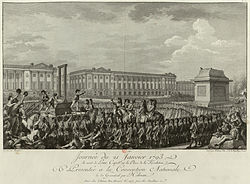 Execution of Louis XVI in the Place de la Révolution. The empty pedestal in front of him had supported a statue of his grandfather, Louis XV, now torn down during one of the many revolutionary riots.
Execution of Louis XVI in the Place de la Révolution. The empty pedestal in front of him had supported a statue of his grandfather, Louis XV, now torn down during one of the many revolutionary riots.
On 15 January 1793, the Convention, composed of 721 deputies, voted on the verdict. Given overwhelming evidence of Louis's collusion with the invaders, the verdict was a foregone conclusion – with 693 deputies voting guilty, none for acquittal, with 23 abstaining. The next day, a roll-call vote was carried out to decide upon the fate of the King, and the result was uncomfortably close for such a dramatic decision. 288 of the Deputies voted against death and for some other alternative, mainly some means of imprisonment or exile. 72 of the Deputies voted for the death penalty, but subject to a number of delaying conditions and reservations. 361 of the Deputies voted for Louis's immediate death.
The next day, a motion to grant Louis XVI reprieve from the death sentence was voted down: 310 of the Deputies requested mercy, but 380 of the Deputies voted for the immediate execution of the death penalty. This decision would be final. On Monday, 21 January 1793, Louis was beheaded by guillotine on the Place de la Révolution. The executioner, Charles Henri Sanson, testified that the former King had bravely met his fate.[29]
As Louis mounted the scaffold he appeared dignified and resigned. He delivered a short speech in which he reasserted his innocence and he pardoned those responsible for his death. He declared himself willing to die and prayed that the people of France would be spared a similar fate. He seemed about to say more when Antoine-Joseph Santerre, a general in the National Guard, cut Louis off by ordering a drum roll. The former King was then quickly beheaded.
Some accounts of Louis's beheading indicate that the blade did not sever his neck entirely the first time. There are also accounts of a blood-curdling scream issuing from Louis after the blade fell but this is unlikely, since the blade severed Louis's spine. It is agreed that while Louis's blood dripped to the ground many members of the crowd ran forward to dip their handkerchiefs in it.[30]
Legacy
The 19th-century historian, Jules Michelet, attributed the restoration of the French monarchy to the sympathy that had been engendered by the execution of Louis XVI. Michelet's Histoire de la Révolution Française and Alphonse de Lamartine's Histoire des Girondins, in particular, showed the marks of the feelings aroused by the revolution's regicide. The two writers did not share the same sociopolitical vision, but they agreed that, even though the monarchy was rightly ended in 1792, the lives of the royal family should have been spared. Lack of compassion at that moment contributed to a radicalization of revolutionary violence and to greater divisiveness among Frenchmen. For the 20th century novelist Albert Camus the execution signaled the end of the role of God in history, for which he mourned. For the 20th century philosopher Jean-François Lyotard the regicide was the starting point of all French thought, the memory of which acts as a reminder that French modernity began under the sign of a crime.[31]
His daughter, Marie-Thérèse-Charlotte, the future Duchess of Angoulême, survived the French Revolution, and she lobbied in Rome energetically for the canonization of her father as a saint of the Catholic Church. Despite his signing of the "Civil Constitution of the Clergy", Louis had been described as a martyr by Pope Pius VI in 1793. In 1820, however, a memorandum of the Congregation of Rites in Rome, declaring the impossibility of proving that Louis had been executed for religious rather than political reasons, put an end to hopes of canonization.
- The Requiem in C minor for mixed chorus by Luigi Cherubini was written in 1816, in memory of Louis XVI.
- The city of Louisville, Kentucky, is named for Louis XVI. In 1780, the Virginia General Assembly bestowed this name in honor of the French king, whose soldiers were aiding the American side in the Revolutionary War. The Virginia General Assembly saw the King as a noble man, but many other Continental delegates disagreed. (At that time, Kentucky was a part of the Commonwealth of Virginia. Kentucky became the 15th State of the United States in 1792.)
- There are numerous other places named "Louisville", such as Louisville, Alabama, Louisville, Georgia, Louisville, Illinois, Louisville, Kansas, Louisville, Nebraska, Louisville, New York, Louisville, Ohio and Louisville, Tennessee, all located in the United States.
In film and literature
Louis XVI has been portrayed in numerous films. In Marie Antoinette (1938), he was played by Robert Morley. More recently, he was depicted in the 2006 film Marie Antoinette by Jason Schwartzman. In Sacha Guitry's Si Versailles m'était conté, Louis was portrayed by one of the film's producers, Gilbert Bokanowski, using the alias Gilbert Boka. Several portrayals have upheld the image of a bumbling, almost foolish king, such as that by Jacques Morel in the 1956 French film Marie-Antoinette reine de France and that by Terence Budd in the Lady Oscar live action film. In Start the Revolution Without Me, Louis XVI is portrayed by Hugh Griffith as a laughable cuckold. Mel Brooks played a comic version of Louis XVI in The History of the World Part 1, portraying him as a libertine who has such a distaste for the peasantry he uses them as targets in skeet shooting.
Ancestors
Bibliography
- Baecque, Antoine De. "From Royal Dignity to Republican Austerity: the Ritual for the Reception of Louis XVI in the French National Assembly (1789–1792)." Journal of Modern History 1994 66(4): 671–696. JSTOR.org
- Burley, Peter. "A Bankrupt Regime." History Today (Jan 1984) 34:36–42. Issn: 0018-2753 Fulltext in EBSCO
- Doyle, William. Origins of the French Revolution (3rd ed. 1999) online edition
- Doyle, William. "The Execution of Louis XVI and the End of the French Monarchy." History Review. (2000) pp 21+ Questia.com, online edition
- Doyle, William (2002). The Oxford History of the French Revolution. UK: Oxford University Press. ISBN 9780199252985. Pages 194–196 deal with the trial of Louis XVI.
- Doyle, William, ed. Old Regime France (2001).
- Dunn, Susan. The Deaths of Louis XVI: Regicide and the French Political Imagination. (1994). 178 pp.
- Hardman, John. Louis XVI: The Silent King (1994) 224 pages, the standard scholarly biography
- Hardman, John. French Politics, 1774–1789: From the Accession of Louis XVI to the Fall of the Bastille. (1995). 283 pp.
- Jones, Colin. The Great Nation: France from Louis XV to Napoleon (2002) Amazon.com, excerpt and text search
- Mignet, François Auguste (1824). "History of the French Revolution from 1789 to 1814". Project Gutenberg. http://www.gutenberg.org/dirs/etext06/8hfrr10.txt. See Chapter VI, The National Convention, for more details on the king's trial and execution.
- Padover, Saul K. The Life and Death of Louis XVI (1939) Questia.com, online edition
- Price, Munro. The Road from Versailles: Louis XVI, Marie Antoinette, and the Fall of the French Monarchy (2004) 425 pp. Amazon.com, excerpt and text search; also published as The Fall of the French Monarchy: Louis XVI, Marie Antoinette and the Baron de Breteuil. (2002)
- Rigney, Ann. "Toward Varennes." New Literary History 1986 18(1): 77–98. Issn: 0028-6087; JSTOR.org, on historiography
- Schama, Simon. Citizens. A Chronicle of the French Revolution (1989), highly readable narrative by scholar Amazon.com, excerpt and text search
- Tackett, Timothy. When the King Took Flight. (2003). 270 pp. Amazon.com, excerpt and text search
Primary sources
- Marie Antoinette. Memoirs of Marie Antoinette, Queen of France and Wife of Louis XVI: Queen of France (1910) Books.Google.com, complete edition online
- Full text of writings of Louis XV in Ball State University's Digital Media Repository.
References
- ^ Andress, David. The Terror, Farrar, Straus and Giroux, New York, 2005, p. 12-13
- ^ Lever, Évelyne, Louis XVI, Librairie Arthème Fayard, Paris, 1985
- ^ Andress, David. "The Terror", p. 12
- ^ Fraser, Antonia, Marie Antoinette, pp.100–102
- ^ Fraser, Antonia, Marie Antoinette, p.127
- ^ Fraser, Antonia, Marie Antoinette, pp.166–167
- ^ Fraser, Antonia, Marie Antoinette, p.164
- ^ Francine du Plessix Gray (7 August 2000). "The New Yorker From the Archive Books". The Child Queen. http://www.newyorker.com/printables/archive/021007fr_archive01. Retrieved 17 October 2006.
- ^ Fraser, Antonia, Marie Antoinette, p.122
- ^ Androutsos, George. "The Truth About Louis XVI's Marital Difficulties". Translated from French. http://www.historyofcircumcision.net/index.php?option=content&task=view&id=78.
- ^ Zweig, Stefan (1933). Marie Antoinette: The Portrait of An Average Woman.
- ^ Fraser, Antonia (2001). Marie Antoinette: The Journey.
- ^ Lever, Evelyne (2001). Marie Antoinette: Last Queen of France.
- ^ Cronin, Vincent (1974). Louis and Antoinette.
- ^ "Dictionary of World Biography". Author: Barry Jones. Published in 1994.
- ^ Charles Porset, Hiram sans-culotte? Franc-maçonnerie, lumières et révolution: trente ans d'études et de recherches, Paris: Honoré Champion, 1999 p. 207.
- ^ Andress, David,(2005) The Terror, pp.13
- ^ John Hardman, Louis XVI, Yale university Press, New Haven and London, 1993 p126
- ^ Baecque, Antoine de, From Royal Dignity to Republican Austerity: The Ritual for the Reception of Louis XVI in the French National Assembly (1789–1792), The Journal of Modern History, Vol. 66, No. 4 (December 1994), p.675.
- ^ a b c "Tipu Sultan and the Scots in India". The Tiger and The Thistle. http://www.tigerandthistle.net/tipu315.htm. Retrieved 2011-07-17.
- ^ The Oxford Illustrated History of the British Army (1994) p. 130.
- ^ Jonathan R. Dull, The French Navy and American Independence: A Study of Arms and Diplomacy, 1774–1787 (1975).
- ^ On finance, see William Doyle, Oxford History of the French Revolution (1989) p. 67-74.
- ^ The influence of sea power upon history, 1660–1783, by Alfred Thayer Mahan p. 461: [1]
- ^ "The History Project - University of California, Davis". Historyproject.ucdavis.edu. http://historyproject.ucdavis.edu/ic/standard/5.00/5.3_1.00/13161.html. Retrieved 2011-07-17.
- ^ Black, Jeremy. ''Britain as a military power, 1688–1815''. http://books.google.com/books?id=Fk_RaalNQAQC&pg=PA183. Retrieved 2011-07-17.
- ^ "News and Views February 2003 - University of Bradford". Brad.ac.uk. 2003-02-11. http://www.brad.ac.uk/admin/pr/february2003/french.php. Retrieved 2011-07-17.
- ^ Price, Munro, Louis XVI and Gustavus III: Secret Diplomacy and Counter-Revolution, 1791–1792, The Historical Journal, Vol. 42, No. 2 (June 1999), p. 441.
- ^ Alberge, Dalya. What the King said to the executioner..., The Times, 8 April 2006. Accessed 26 June 2008.
- ^ Andress, David, The Terror, 2005, p. 147.
- ^ See Susan Dunn, The Deaths of Louis XVI: Regicide and the French Political Imagination. (1994).
External links
- Findagrave.com
- Encyclopaedia Britannica, Louis XVI – full access article
- Full text of writings of Louis XVI in Ball State University's Digital Media Repository
- Works by or about Louis XVI of France in libraries (WorldCat catalog)
Louis XVI of FranceCadet branch of the Capetian dynastyBorn: 23 August 1754 Died: 21 January 1793Regnal titles Preceded by
Louis XVKing of France and Navarre
10 May 1774 – 1 October 1791Succeeded by
National Convention;
eventually Napoléon I
as Emperor of the FrenchKing of the French
1 October 1791 – 21 September 1792French royalty Preceded by
LouisDauphin of France
20 December 1765 – 10 May 1774Succeeded by
Louis-JosephPreceded by
Louis, Dauphin of FranceHeir to the Throne
as Heir apparent
20 December 1765 – 10 May 1774Succeeded by
Louis, Count of ProvenceTitles in pretence Loss of title
Monarchy abolished— TITULAR —
King of France and Navarre
1 October 1791 – 21 January 1793
Reason for succession failure:
French Revolution (1789–1799)Succeeded by
Louis XVIIDauphins of France House of Bourbon Louis XIII · Louis XIV · Louis, Le Grand Dauphin · Louis, Le Petit Dauphin · Louis · Louis XV · Louis · Louis Auguste · Louis Joseph · Louis Charles · Louis Antoine
Princes of France The first generation are the children of Henri IV; these males held the rank of Son of France or Grand son of France;1st Generation 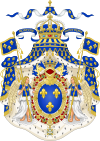
2nd Generation 3rd Generation Louis, Dauphin of France · Philippe Charles, Duke of Anjou* · Louis François, Duke of Anjou* · Philippe Charles, Duke of Valois* · Alexandre Louis, Duke of Valois* · Philippe, Duke of Orléans4th Generation 5th Generation Louis, Duke of Brittany* · Louis, Duke of Brittany* · Louis XV6th Generation Louis, Dauphin of France · Philippe, Duke of Anjou*7th Generation 8th Generation Louis Joseph, Dauphin of France* · Louis XVII* · Louis Antoine, Duke of Angoulême* · Charles Ferdinand, Duke of Berry*died without surviving issueList of French monarchs Detailed Family Tree • Simplified Family TreeMerovingians
(481–751)Clovis Ist (481–511) • Chlothar I (511–561) • Charibert I (561–567) • Guntram (561–593) • Chilperic I (561–584) • Sigebert I (561–575) • Chlothar II (584–629) • Dagobert I (629–639) • Sigebert II (639–656) • Clovis II (639–657) • Chlothar III (657–673) • Theuderic III (673–691) • Clovis III (691–695) • Childebert III (695–711) • Dagobert III (711–715) • Chilperic II (715–721) • Chlothar IV (717–719) • Thierry IV (721–737) • Childeric III (737–751)Carolingians
(843–888, 898–922, 936–987)Pepin III (751–768) • Carloman I (768–771) • Charlemagne (768–814) • Louis I (814–840) • Charles I (843–877) • Louis II (877–879) • Louis III (879–882) • Carloman II (879–884) • Charles II (885–888) • Charles III (898–922) • Louis IV (936–954) • Lothair IV (954–986) • Louis V (986–987)Robertians
(888–898, 922–923)Eudes of Paris (888–898) • Robert I (922–923)Bosonids
(923–936)Raoul (923–936)House of Capet
(987–1328)Hugh (987–996) • Robert II (996–1031) • Henry I (1031–1060) • Philip I (1060–1108) • Louis VI (1108–1137) • Louis VII (1137–1180) • Philip II (1180–1223) • Louis VIII (1223–1226) • Louis IX (1226–1270) • Philip III (1270–1285) • Philip IV (1285–1314) • Louis X (1314–1316) • John I (1316) • Philip V (1316–1322) • Charles IV (1322–1328)House of Valois
(1328–1498)Philip VI (1328–1350) • John II (1350–1364) • Charles V (1364–1380) • Charles VI (1380–1422) • Charles VII (1422–1461) • Louis XI (1461–1483) • Charles VIII (1483–1498)House of Valois-Orléans
(1498–1515)Louis XII (1498–1515)House of Valois-Angoulême
(1515–1589)Francis I (1515–1547) • Henry II (1547–1559) • Francis II (1559–1560) • Charles IX (1560–1574) • Henry III (1574–1589)House of Bourbon
(1589–1792)Henry IV (1589–1610) • Louis XIII (1610–1643) • Louis XIV (1643–1715) • Louis XV (1715–1774) • Louis XVI (1774–1792) • Louis XVII (claimant, 1792–1795)House of Bonaparte
First Empire (1804–1814, 1815)Napoleon I (1804–1814, 1815) • Napoleon II (1815)House of Bourbon
Bourbon Restoration
(1814, 1815–1830)House of Orléans
July Monarchy (1830–1848)Louis Philippe I (1830–1848)House of Bonaparte
Second Empire (1852–1870)Napoleon III (1852–1870)Pretenders to the French throne since 1792 Monarchy in exile (1792–1815) 1792 Louis XVI 1793 Louis XVII 1795 Louis XVIII 1814 1815
Legitimist pretenders (1830–present) 1830 Charles X 1836 Louis XIX 1844 Henri V 1883 Jean III 1887 Charles XI 1909 Jacques I 1931 Alphonse I 1936 Alphonse II 1941 Jacques II 1975 Alphonse III 1989 Louis XX presentOrléanist pretenders (1848–present) 1848 Louis-Philippe I 1850 Philippe VII (or Louis-Philippe II) 1894 Philippe VIII 1926 Jean III 1940 Henri VI 1999 Henri VII presentBonapartist Prince Imperial (1814–present) 1814 1815 Napoléon I 1821 Napoléon II 1832 Joseph 1844 Louis 1846 Napoléon III (Emperor 1852–1870) 1873 Napoléon IV Eugene 1879 Napoléon V Victor 1926 Napoléon VI Louis 1997 Napoléon VII Charles/Napoléon VIII Jean-Christophe present (disputed)Bonapartist Prince Canino (1832–1924) House of Bourbon Henry IV of France Spouse(s)ChildrenSiblingsHenri, Duke of Beaumont (1551–1553) · Louis, Count of Marle (1555–1557) · Madeleine (1556) · Catherine, Duchess of LorraineIllegitimate childrenCésar, Duke of Vendôme · Catherine Henriette, Duchess of Elbeuf · Alexandre, Chevalier de Vendôme · Henri, Duke of Verneuil · Gabrielle Angelique, Duchess of La Valette and Epernon · Antoine, Count of Moret · Jeanne Baptiste, Abess of Fontevraud · Marie Henriette, Abess of ChellesGrandchildrenAnne Marie Louise, Duchess of Montpensier · Marguerite Louise, Grand Duchess of Tuscany · Élisabeth Marguerite, Duchess of Alençon and Angoulême · Françoise Madeleine, Duchess of Savoy · Princess Marie Anne · Jean Gaston, Duke of Valois · Louis XIV of France · Philippe, Duke of OrléansLouis XIII of France Spouse(s)ChildrenGrandchildrenLouis, Dauphin of France · Princess Anne Élisabeth · Princess Marie Anne · Princess Marie Therèse, Madame Royale · Philippe Charles, Duke of Anjou · Louis François, Duke of Anjou · Marie Louise, Queen of Spain · Philippe Charles, Duke of Valois · Anne Marie, Queen of Sardinia · Alexandre Louis, Duke of Valois · Philippe Charles, Duke of Orléans · Élisabeth Charlotte, Duchess of LorraineGreat
grandchildrenLouis XIV of France Spouse(s)ChildrenLouis, Dauphin of France · Princess Anne Élisabeth · Princess Marie Anne · Princess Marie Therèse, Madame Royale · Philippe Charles, Duke of Anjou · Louis François, Duke of AnjouIllegitimate childrenMarie Anne, Princess of Conti · Louis, Count of Vermandois · Louis Auguste, Duke of Maine · Louis César, Count of Vexin · Louise Françoise, Duchess of Bourbon · Louise Marie Anne, Mademoiselle de Tours · Françoise Marie, Duchess of Orléans · Louis Alexandre, Count of Toulouse · Louise, Baroness of La QueueGrandchildrenLouis, Duke of Burgundy · King Felipe of Spain+ · Charles, Duke of Berry · Louis Auguste, Prince of Dombes · Louis Charles, Count of Eu · Louise Françoise, Mademoiselle du Maine · Louis Jean Marie, Duke of PenthièvreGreat
grandchildrenLouis, Duke of Brittany · Louis, Duke of Brittany · Louis XV of France · Louis I of Spain* · Felipe of Spain* · Felipe of Spain* · Ferdinand VI of Spain* · Charles III of Spain* · Francisco of Spain* · Mariana Víctoria, Queen of Portugal* · Philip, Duke of Parma* · Maria Teresa Rafaela, Dauphine of France* · Luis, Count of Chinchón* · Maria Antonietta, Queen of Sardinia* · Charles, Duke of Alençon · Marie Louise Élisabeth d'Alençon · Louis Alexandre, Prince of LamballeLouis XV of France Spouse(s)ChildrenLouise Élisabeth, Duchess of Parma · Princess Henriette · Princess Louise · Louis, Dauphin of France · Philippe, Duke of Anjou · Marie Adélaïde, Duchess of Louvois · Princess Victoire · Sophie, Duchess of Louvois · Princess Thérèse · Princess Louise MarieGrandchildrenPrincess Marie Therèse, Madame Royale · Princess Marie Zéphyrine · Louis, Duke of Burgundy · Xavier, Duke of Aquitaine · Louis XVI of France · Louis XVIII of France · Charles X of France · Clothilde, Queen of Sardinia · Princess ÉlisabethIllegitimate children
includedCharles de Vintimille · Agathe Louise de Saint-Antoine · Philippe, Duke of Narbonne-Lara · Louis, Count of Narbonne-LaraLouis XVI of France Spouse(s)ChildrenMarie Thérèse, Duchess of Angoulême · Louis Joseph, Dauphin of France · Louis XVII of France · Princess Sophie HélèneLouis XVII of France NoteLouis had no children; he died aged 10 in 1795. His uncle, the future Louis XVIII of France, proclaimed himself regent but both titles were disputed.
See Bourbon Restoration.Louis XVIII of France Spouse(s)Charles X of France Spouse(s)ChildrenLouis Antoine, Duke of Angoulême · Sophie, Mademoiselle · Charles Ferdinand, Duke of Berry · Marie Thérèse, Mademoiselle d'AngoulêmeGrandchildrenPrincess Louise Élisabeth · Prince Louis · Louise Marie Thérèse, Duchess of Parma · Henry, Count of ChambordNotes: *also an Infante or Infanta of Spain · **also an Archduchess of Austria · ***both · +Philip was the first Bourbon king of Spain, the country's present ruling house
French Revolution Significant civil and political events by year 1788 1789 Reveillon riot (28 Apr 1789) Convocation of the Estates-General (5 May 1789) · National Assembly (17 Jun to 9 Jul 1790) · Tennis Court Oath (20 Jun 1789) · Storming of the Bastille (14 Jul 1789) · Great Fear (20 Jul to 5 Aug 1789) · Declaration of the Rights of Man and of the Citizen (27 Aug 1789) · Women's March on Versailles (5 Oct 1789)1790 Abolition of the Parlements (3 Feb 1790) · Abolition of the Nobility (19 Jun 1790) · Civil Constitution of the Clergy (12 Jul 1790) · Abolition of the Parlements (12 Jul 1790)1791 Flight to Varennes (20 and 21 Jun 1791) · Champ de Mars Massacre (17 Jul 1791) · Declaration of Pillnitz (27 Aug 1791) · The Constitution of 1791 (3 Sep 1791) · Legislative Assembly (1 Oct 1791 to Sep 1792) · Self-denying ordinance (30 Sep 1791)1792 Brunswick Manifesto (25 Jul 1792) · Paris Commune becomes insurrectionary (Jun 1792) · 10th of August (10 Aug 1792) · September Massacres (Sep 1792) · National Convention (20 Sep 1792 to 26 Oct 1795) · First republic declared (22 Sep 1792)1793 Louis Capet is guillotined (21 Jan 1793) · Revolutionary Tribunals (9 Mar 1793 to 31 May 1795) · Reign of Terror (27 Jun 1793 to 27 July 1794) · (Committee of Public Safety · Committee of General Security) · Fall of the Girondists (2 Jun 1793) · Assassination of Marat (13 Jul 1793) · Levée en masse (23 Aug 1793) · Law of Suspects (17 Sep 1793) · Marie Antoinette is guillotined (16 Oct 1793) · Anti-clerical laws (throughout the year)1794 Danton & Desmoulins guillotined (5 Apr 1794) · Law of 22 Prairial (10 Jun 1794) · Thermidorian Reaction (27 Jul 1794) · White Terror (Fall 1794) · Closing of the Jacobin Club (11 Nov 1794)1795 1797 1799 Coup of 30 Prairial Year VII (18 Jun 1799) · The coup of 18 Brumaire (9 Nov 1799) · Constitution of the Year VIII (24 Dec 1799) · ConsulateRevolutionary wars 1792 1793 First Coalition · Siege of Toulon (18 Sep to 18 Dec 1793) · War in the Vendée · Battle of Neerwinden) · Battle of Famars (23 May 1793) · Capture of San Pietro and Sant'Antioco (25 May 1793) · Battle of Kaiserslautern · Siege of Mainz · Battle of Wattignies · Battle of Hondshoote · Siege of Bellegarde · Battle of Peyrestortes (Pyrenees) · First Battle of Wissembourg (13 Oct 1793) · Battle of Truillas (Pyrenees) Second Battle of Wissembourg (26 and 27 Dec 1793)1794 Battle of Villers-en-Cauchies (24 Apr 1794) · Battle of Boulou (Pyrenees) (30 Apr and 1 May 1794) · Battle of Tournay (22 May 1794) · Battle of Fleurus (26 Jun 1794) · Chouannerie · Battle of Tourcoing (18 May 1794) · Battle of Aldenhoven (2 Oct 1794)1795 1796 Battle of Lonato (3 and 4 Aug 1796) · Battle of Castiglione (5 Aug 1796) · Battle of Theiningen · Battle of Neresheim (11 Aug 1796) · Battle of Amberg (24 Aug 1796) · Battle of Würzburg (3 Sep 1796) · Battle of Rovereto (4 Sep 1796) · First Battle of Bassano (8 Sep 1796) · Battle of Emmendingen (19 Oct 1796) · Battle of Schliengen (26 Oct 1796) · Second Battle of Bassano (6 Nov 1796) · Battle of Calliano (6 and 7 Nov 1796) · Battle of the Bridge of Arcole (15 to 17 Nov 1796) · The Ireland Expedition (Dec 1796)1797 Naval Engagement off Brittany (13 Jan 1797) · Battle of Rivoli (14 and 15 Jan 1797) · Battle of the Bay of Cádiz (25 Jan 1797) · Treaty of Leoben (17 Apr 1797) · Battle of Neuwied (18 Apr 1797) · Treaty of Campo Formio (17 Oct 1797)1798 French Invasion of Egypt (1798–1801) · Irish Rebellion of 1798 (23 May – 23 Sep 1798) · Quasi-War (1798 to 1800) · Peasants' War (12 Oct to 5 Dec 1798)1799 Second Coalition (1798-1802) · Siege of Acre (20 Mar to 21 May 1799) · Battle of Ostrach (20 and 21 Mar 1799) · Battle of Stockach (25 Mar 1799) · Battle of Magnano (5 Apr 1799) · Battle of Cassano (27 Apr 1799) · First Battle of Zürich (4-7 Jun 1799) · Battle of Trebbia (19 Jun 1799) · Battle of Novi (15 Aug 1799) · Second Battle of Zürich (25 and 26 Sep 1799)1800 Battle of Marengo (14 Jun 1800) · Battle of Hohenlinden (3 Dec 1800) · League of Armed Neutrality (1800-1802)1801 Treaty of Lunéville (9 Feb 1801) · Treaty of Florence (18 Mar 1801) · Battle of Algeciras (8 Jul 1801)1802 Treaty of Amiens (25 Mar 1802)Military leaders French
army officersEustache Charles d'Aoust · Pierre Augereau · Alexandre de Beauharnais · Jean-Baptiste Bernadotte · Louis Alexandre Berthier · Jean-Baptiste Bessières · Guillaume Marie Anne Brune · Jean François Carteaux · Jean Étienne Championnet · Chapuis de Tourville · Adam Philippe, Comte de Custine · Louis-Nicolas Davout · Louis Charles Antoine Desaix · Jacques François Dugommier · Charles François Dumouriez · Pierre Marie Barthélemy Ferino · Louis-Charles de Flers · Paul Grenier · Emmanuel de Grouchy · Jacques Maurice Hatry · Lazare Hoche · Jean-Baptiste Jourdan · François Christophe Kellermann · Jean-Baptiste Kléber · Pierre Choderlos de Laclos · Jean Lannes · Charles Leclerc · Claude Lecourbe · François Joseph Lefebvre · Jacques MacDonald · Jean-Antoine Marbot · Jean Baptiste de Marbot · François-Séverin Marceau · Auguste de Marmont · André Masséna · Bon-Adrien Jeannot de Moncey · Jean Victor Marie Moreau · Édouard Adolphe Casimir Joseph Mortier · Joachim Murat · Michel Ney · fr:Pierre-Jacques Osten · Nicolas Oudinot · Catherine-Dominique de Pérignon · Charles Pichegru · Józef Antoni Poniatowski · Laurent de Gouvion Saint-Cyr · Barthélemy Louis Joseph Schérer · Jean-Mathieu-Philibert Sérurier · Joseph Souham · Nicolas Jean-de-Dieu Soult · Louis Gabriel Suchet · Belgrand de Vaubois · Claude Victor-Perrin, Duc de BellunoFrench
naval officersOpposition
military figuresSir Ralph Abercromby (British) · József Alvinczi (Austrian) · Archduke Charles of Austria · Duke of Brunswick (Prussian) · Count of Clerfayt (Walloon fighting for Austria) · Luis Firmin de Carvajal (Spanish) · Karl Aloys zu Fürstenberg (Russian) · Prince of Hohenlohe-Ingelfingen (Prussian) · Friedrich Freiherr von Hotze (Swiss in Austrian service) Count of Kalckreuth (Austrian) · Alexander Korsakov (Russian) · Pál Kray (Hungarian serving Austria) · Prince of Lambesc (French in the service of Austria) · Maximilian Baillet de Latour (Walloon in the service of Austria) · Karl Mack von Leiberich (Austrian) · Rudolf Ritter von Otto (Saxon fighting for Austria) · Antonio Ricardos (Spanish) · Sir James Saumarez (British admiral) · Prince Josias of Saxe-Coburg-Saalfeld (Austrian) · William V, Prince of Orange (Dutch) · Sir Edward Pellew (British admiral) · Peter Vitus von Quosdanovich (Austrian) · Prince Heinrich XV Reuss of Plauen (Austrian) · Alexander Suvorov (Russian) · Johann Mészáros von Szoboszló (Hungarian in Austrian service) · Karl Philipp Sebottendorf (Austrian) · Dagobert von Wurmser (Austrian) · Duke of York (British)Other important figures and factions Royals and
RoyalistsCharles X of France · Louis XVI · Louis XVII · Louis XVIII · Louis Antoine, Duke of Enghien · Louis Henri, Prince of Condé · Louis Joseph, Prince of Condé · Louis Philippe of France · Marie Antoinette · Madame de Lamballe · Madame du Barry · Louis de Breteuil · Loménie de Brienne · Charles Alexandre de Calonne · Chateaubriand · Jean Chouan · Grace Elliott · Arnaud de Laporte · Jean-Sifrein Maury · Mirabeau · Jacques NeckerFeuillants Girondists Montagnards Paul Nicolas, vicomte de Barras · Georges Couthon · Georges Danton · Jacques Louis David · Camille Desmoulins · Roger Ducos · Jean Marie Collot d'Herbois · Jean-Paul Marat · Prieur de la Côte-d'Or · Prieur de la Marne · Maximilien Robespierre · Gilbert Romme · Jean Bon Saint-André · Louis de Saint-Just · Jean-Lambert Tallien · Bertrand Barère de VieuzacHébertists Bonapartists Napoléon Bonaparte · de Cambacérès · Jacques-Louis David · Jean Debry · Joseph Fesch · Charles François Lebrun · Philippe-Antoine Merlin de DouaiOthers: Jean-Pierre-André Amar · François-Noël Babeuf · Jean Sylvain Bailly · François-Marie, marquis de Barthélemy · Jacques Nicolas Billaud-Varenne · Lazare Nicolas Marguerite Carnot · André Chénier · Jean-Jacques Duval d'Eprémesnil · Antoine Quentin Fouquier-Tinville · Olympe de Gouges · Father Henri Grégoire · Philippe-François-Joseph Le Bas · Jacques-Donatien Le Ray · Jean-Baptiste Robert Lindet · Guillaume-Chrétien de Malesherbes · Antoine Christophe Merlin de Thionville · Jean Joseph Mounier · Pierre Samuel du Pont de Nemours · François de Neufchâteau · Louis Michel le Peletier de Saint-Fargeau · Pierre Louis Prieur · Jean-François Rewbell · Louis Marie de La Révellière-Lépeaux · Marquis de Sade · Antoine Christophe Saliceti · Emmanuel-Joseph Sieyès · Madame de Staël · Talleyrand · Thérésa Tallien · Gui-Jean-Baptiste Target · Catherine Théot · Marc-Guillaume Alexis Vadier · Jean-Henri Voulland · EnragésInfluential thinkers The Bonapartes Cultural impact La Marseillaise · Fabre d'Églantine · French Tricolour · Liberté, égalité, fraternité · Bastille Day · Panthéon · French Republican Calendar · Cult of the Supreme Being · Cult of Reason · Sans-culottes · Metric system
Quatrevingt-treize · A Tale of Two Cities · The Scarlet Pimpernel · Scaramouche · La Révolution française · Orphans of the Storm · DantonCategories:- Louis XVI of France
- 1754 births
- 1793 deaths
- 1793 crimes
- Burials at the Basilica of St Denis
- Dauphins of France
- Dukes of Berry
- Executed royalty
- Executed French people
- Executed reigning monarchs
- Knights of the Golden Fleece
- Kings of France
- Leaders ousted by a coup
- Murdered monarchs
- People executed by guillotine during the French Revolution
- People executed for treason against France
- Princes of Andorra
- Princes of France (Bourbon)
- Recipients of the Order of the Holy Spirit
- Roman Catholic monarchs
Wikimedia Foundation. 2010.

